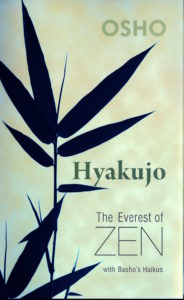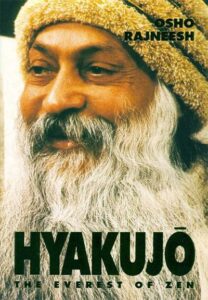with Basho’s Haiku’s
Two great Contributions to Zen by Hyakujo
Hyakujo made two great contributions to Zen that served as landmarks of change with the Zen Tradition, and which express the elements of living Zen. The first was his treatise on “sudden enlightenment,” an understanding that gradual preparation of the soil creates the environment for sudden illumination or understanding to hit like one like lightning after years of searching.
His second contribution was the creation of monasteries, where thousands of people gathered together with a single direction, a shared deep urgency to become the buddha; where work and meditation went hand in hand; where a climate for realization, an energyfield for enlightenment was generated. He also created the Chinese Tea Ceremony where something so ordinary as drinking tea becomes a meditation.
Zen Meester Hyakujo, the Everest of Zen, met Basho’s Haiku’s
In Hyakujo the Everest of Zen belicht Osho het begrip ‘plotselinge verlichting’ (‘sudden enlightenment’) van de Chinese Zen meester Hyakujo, terwijl hij laat zien dat iedereen al een boeddha is. Geen meester, zo zegt hij, kan je iets geven; hij kan alleen je valse overtuigingen wegnemen. Hyakujo’s  tweede markante bijdrage aan Zen was het stichten van Kloosters om de omgeving te creëren waar men het boeddha-zijn kon realiseren. Zijn idee was dat een geleidelijke voorbereiding, waarin werk en meditatie hand in hand gaan, de realisatie kan laten gebeuren. Deze structuur gaat in Zen kloosters tot op de dag van vandaag door.
tweede markante bijdrage aan Zen was het stichten van Kloosters om de omgeving te creëren waar men het boeddha-zijn kon realiseren. Zijn idee was dat een geleidelijke voorbereiding, waarin werk en meditatie hand in hand gaan, de realisatie kan laten gebeuren. Deze structuur gaat in Zen kloosters tot op de dag van vandaag door.
Osho illustreert Hyakujo’s inzicht. “Als je een huis, een tuin, een schildering of een gedicht wilt realiseren, gaat dat tijd kosten. Er is echter een ding dat geen tijd kost omdat het de tijd voorbij is en dat is je boeddha zijn. Je springt gewoon uit de tijd en je ontdekt jezelf zoals je altijd geweest bent en altijd zult zijn – je intrinsieke natuur.”
Deze Zen anekdotes en dialogen zijn er niet om kennis aan te reiken – ze zijn methodes voor transformatie.
In het boek zijn diverse haiku’s van Basho opgenomen. Osho licht de haiku’s telkens toe. Het zijn geen gewone gedichten. Er wordt iets met woorden geschilderd. Bijvoorbeeld deze haiku van Basho:
I clap my hands
and with the echoes
it begins the dawn –
The summer moon
Basho is one of the greatest poets of the world, states Osho, but he has written only haiku’s – very symbolic but very miraculous, very simple but very mysterious. They are all understood through visualization, because Zen does not believe in words. Visualise and perhaps you may have some understanding. “I clap my hands and with the echoes” – in the mountains – “it begins to dawn – the summer moon.”
The summer moon is still hanging and the sun is going to rise. And I have clapped my hands, and the echoes are still resounding in the mountains. It is just a painting in words.
Het boek Hyakujo the Everest of Zen is verkrijgbaar via internet en als audiobook
HYAKUJO’S REPLIEK AAN DE GELEERDEN
Hyakujo The Everest of Zen, excerpt Chapter 5
“Ordinarily, the meditator is thought to be in the emptiness, in the ultimate void. But these forming teachers, who were only scholars of the vinaya scriptures of Gautam Buddha…
“The master of the vinaya sect must have been very skeptical of Zen. It is his skepticism that said, you zen masters do a lot of tumbling about in the emptiness of the void.
“Scholars always think that meditators are wasting their time just sitting silently doing nothing. Scholars think they are doing great work creating great systems of thought and philosophy, and these meditators simply sit with their closed eyes. To the scholars, the meditators seem to be just lazy people who have found a good name, meditation, just to hide the laziness.
“So his question was not sincere and honest, it was rather an effort to make a laughingstock of Hyakujo. But it was difficult – it is always difficult. A scholar is not even the dust underneath the feet of a meditator. He knows nothing of the heights of consciousness. Hyakujo did well, he did not felt offended.
“on the contrary, venerable sir, it is you who tumble a lot in the emptiness of the void.
“This must have come as a shock to the vinaya master: ′How can that be?′ “The scriptures, continued hyakujo, are just words – mere ink and paper – and everything of that sort is just an empty device. All those words and phrases are based on something people once heard – they are nothing but emptiness. You, venerable sir, cling to the mere letter of the doctrine, so of course you tumble about in the void.
“Facing an enlightened man is a rare experience in the sense, that you cannot make a laughingstock of him.
“He turned the whole thing on the scholar: ′Rather than saying that we Zen people are tumbling in the emptiness and the void, calling it meditation… the truth is that you scholars are tumbling in the emptiness and void. What are your scriptures? Just paper and ink, mere words spoken by somebody, but those words are always empty. The moment they reach to the paper, to the ink, they don′t have life.
“You are really tumbling into emptiness. We are not tumbling into emptiness, we are becoming emptiness, and that is a totally different thing. We are enjoying the emptiness, we are finding that emptiness is our nature, that out of this emptiness arises everything – our very life source.” Osho


